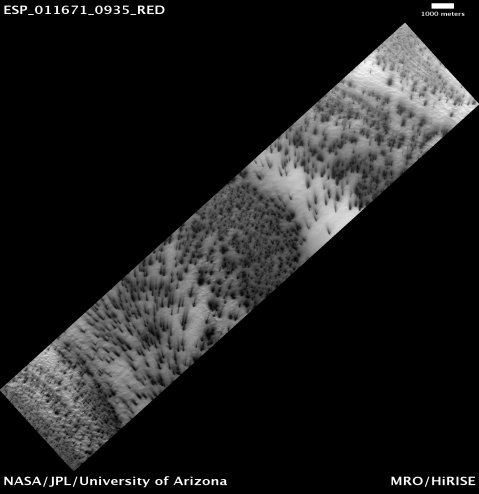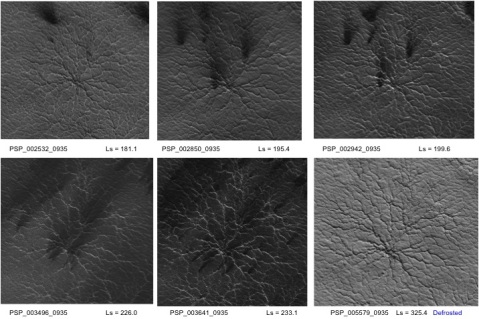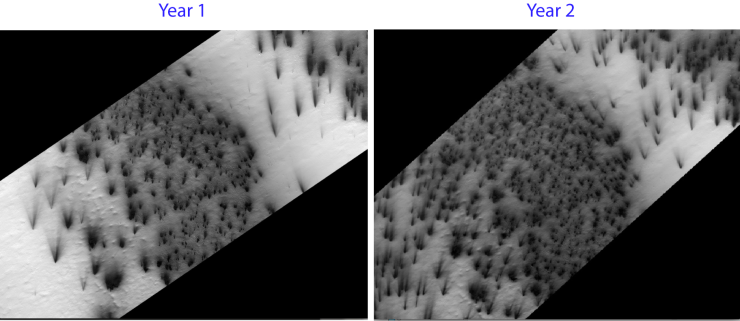European Planetary Science Congress
Every fall the European Planetary Science Congress takes place to bring together planetary scientists from all over the world. We discuss our latest research results, new data, our new theories and ideas, and new concepts for missions.
As a group we are committed to sharing our ideas with all of the world, not just our professional colleagues. So there are always sessions on outreach and education.
This year I submitted an abstract to describe our Planet Four experience. It has been overwhelmingly positive, and I think my colleagues will be intrigued by our approach.
Candy Hansen
Planet Four Principal Investigator
Brand New Images – Year 1 Data
Today we have a post by Dr. Candice (Candy) Hansen, principal investigator (PI) of Planet Four. Dr. Hansen also serves as the Deputy Principal Investigator for HiRISE (the camera providing the images of spiders, fans, and blotches seen on the site). She is also a Co-Investigator on the Ultraviolet Imaging Spectrograph on the Cassini spacecraft in orbit around Saturn. Additionally she is a member of the science team for the Juno mission to Jupiter. Dr. Hansen is responsible for the development and operation of JunoCam, an outreach camera that will involve the public in planning images of Jupiter.
Wow – I just checked Planet Four and found that we had passed 70,000 participants; 70,334 to be exact, as of today. Thank you all for your many hours of hard work (and fun!).
To keep our most dedicated folks going we’ve added the first year of Mars Reconnaissance Orbiter operation (Year 1) to the image collection, although we are not quite finished with Year 2 and Year 3. We started with Year 2 and Year 3 mainly because we were much better at picking good locations and configuring the camera properly. Year 1 is a little more challenging, but interestingly the spring was also rather different from that of the subsequent years. Just like on Earth in some years we have more severe winter storms than others.

Region dubbed Manhattan thawing in Year 1 – You can find more about the observation at http://hirise.lpl.arizona.edu/PSP_002876_0935

Manhattan defrosting in Year 2. Many more fans than appear in Year 1. You can find more about the observation at http://hirise.lpl.arizona.edu/ESP_012739_0935
In this case it appears that there was more frost and ice in Year 1 than Year 2 or 3, but it could also be that it just warmed up earlier in the latter years. So give it your best effort because I think the results will be fascinating.
In the meantime we are busy with our part of the task – digesting all of your measurements and figuring out what they are telling us about Mars. Sometimes I feel like we aren’t holding up our end of the bargain, but then again there are just four of us, and over 70,000 of you!
As you can see from Meg’s post, NASA HQ has taken notice of this effort. I reported on the Planet Four experience at our last HiRISE team meeting and a number of my colleagues were excited about other potential citizen science projects. Go Zooniverse!
Help us understand how Year 1’s weather and climate differs from Year 2 and Year 3 by mapping the fans and blotches on the new never-before-seen images on Planet Four today.
A Message from the PI
Today we have a post by Dr. Candice (Candy) Hansen, principal investigator (PI) of Planet Four. Dr. Hansen also serves as the Deputy Principal Investigator for HiRISE (the camera providing the images of spiders, fans, and blotches seen on the site). She is also a Co-Investigator on the Ultraviolet Imaging Spectrograph on the Cassini spacecraft in orbit around Saturn. Additionally she is a member of the science team for the Juno mission to Jupiter. Dr. Hansen is responsible for the development and operation of JunoCam, an outreach camera that will involve the public in planning images of Jupiter.
Dear Citizen Science Colleagues,
I have been lurking on the chat pages and reading your comments and thoroughly enjoying this whole experience. It is hard to believe that just last December Arfon and I were still drawing diagrams on napkins. Now we have a Zooniverse project underway!
Anya and Michael and I have been discussing this project for several years; Meg and I actually discussed this concept when she was still a graduate student. We were always daunted by the sheer amount of image processing we would have to do.
So now with all of your help we will be able to move forward. The spring season on Mars is a very non-terrestrial experience, as you have seen as you’ve looked at the images. The channels we see carved in the surface are there because the dry ice seasonal polar cap goes directly from solid to gas, and that pressurized gas erodes the surface. The eroded surface material is carried up out onto the surface of the seasonal ice and is deposited in the fans that you have been identifying and measuring.
We want to learn more about this unearthly process, so with your help we will now be able to calculate our first result – the number of fans that erupt as the spring goes by. The overall number of fans as time passes records the level of activity as the overlying ice thickness and level of sunlight changes.
Our objectives that are associated with understanding the weather in the spring will take longer to tease out. We will keep you posted as we make progress.
When an image cutout has been reviewed by 100 people it is retired. At this point you have completed the analysis of 34% of the 42,903 image cutouts. 75% of the cutouts have been reviewed by more than 50 people.
You have been analyzing images from the second and third spring seasons observed by the Mars Reconnaissance Orbiter. We will have images from the first spring ready to go soon, and those from year 4 in another month or two.
We have ideas for other projects – we hope you will continue to enjoy working with us. Your effort and enthusiasm are really an inspiration to us!
Sincerely,
Dr. Candice Hansen
Mars Fan Club
Ever fancied taking a trip to the planet Mars? On Planet Four (http://www.planetfour.org) we’re asking everyone to help us find ‘fans’ on the Martian surface. Your classifications on this site will enable researchers to better understand the climate and surface of Mars. The images you see here are taken using a high-resolution camera in orbit around the Red Planet. We collect together everybody’s markings of objects on these images and average the result. This is a task that computers are not reliable at, but which humans are really good at. By crowdsourcing your efforts, we can produce data that will show us what is happening in these images.
Every winter Mars’ polar region is blanketed by a layer of frozen carbon dioxide (dry ice). In the Martian spring, this temporary polar cap warms back up and rapidly changes directly from ice to gas (a process called sublimation). This produces geyser-like eruptions through weak spots in the polar cap. Dust is trapped in these eruptions and is carried away by the wind where it then falls in a fan shape across the surface nearby – you can see these fans in the images on this page.
Over the winter the seasonal ice layer is transformed to translucent slab ice, which allows sunlight to penetrate to the ground below in the spring. The ground warms up causing the ice to sublimate from the bottom. This results in gas becoming trapped below the ice layer, under increasing pressure. When a crack or a rupture develops the gas flows out the opening. The escaping gas carries along loose material eroded from the ground. The gas and fine material flow up to the top of the ice layer and out into the ambient wind, as shown in the diagram above. The material lands on top of the seasonal ice layer, downwind of the vent, in fan-shaped deposits. After the seasonal ice layer is gone the fans blend back into the surface material and are no longer visible.
This same activity occurs every spring, and slowly erodes channels in the ground. Often the channels are radially organized, thus earning the colloquial name “spiders”, and more formally “araneiform.” Channels are wide and shallow, generally less than 2 meters deep. In the winter the spiders are visible because the ice is draped over them; in the summer when the terrain is ice-free we see that the spiders are indeed channels carved into the surface, shown in the time-lapse sequence below.

Timelapse sequence of a spider initially covered with ~1m of ice (upper left), to ice-free (lower right).
The fans are markers for the wind direction and speed at the time that the gas was escaping and carrying its load of entrained material. Sometimes the vents close and re-open and sometimes the wind changes direction, with the result that we see multiple fans from a single source region. This is all raw data that can be compared to predictions of models for Mars’ atmospheric dynamics, known as global circulation models (GCMs). Sometimes when the conditions are just right the gas will condense into fresh frost particles and form bright fans.
We hope to share more about the background to this project via this blog. Meanwhile, why not go and find some fans? Visit http://www.planetfour.org to start classifying.
Welcome to Planet Four
…well not literally. You’re still on Earth – don’t worry.



